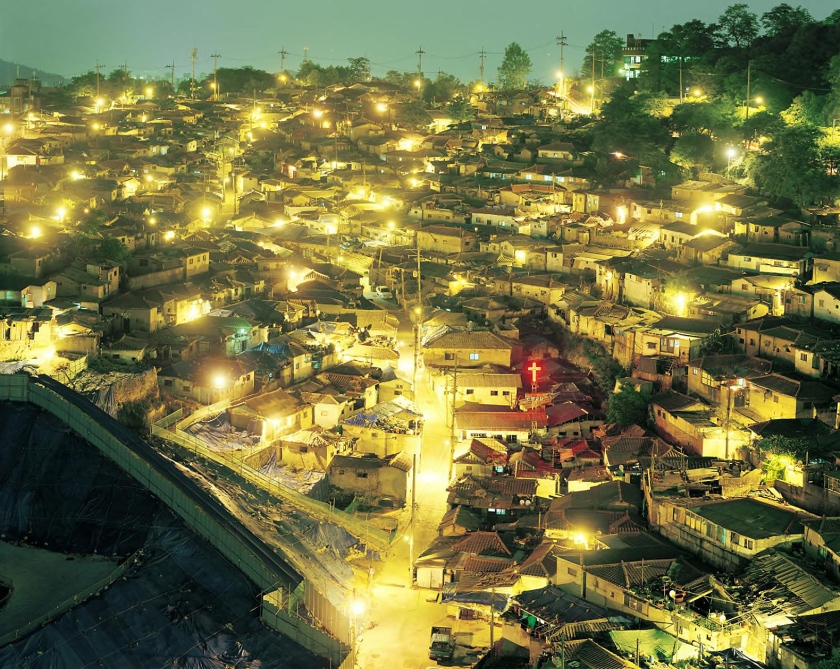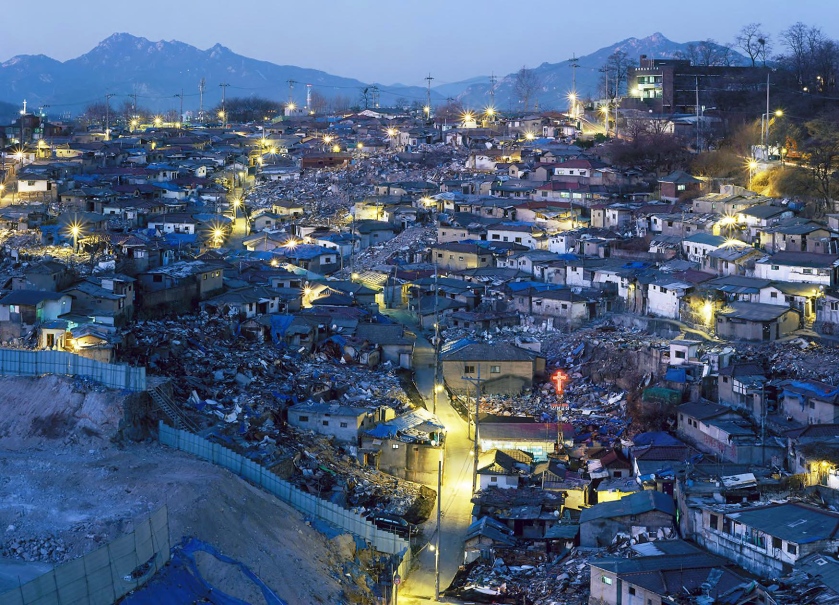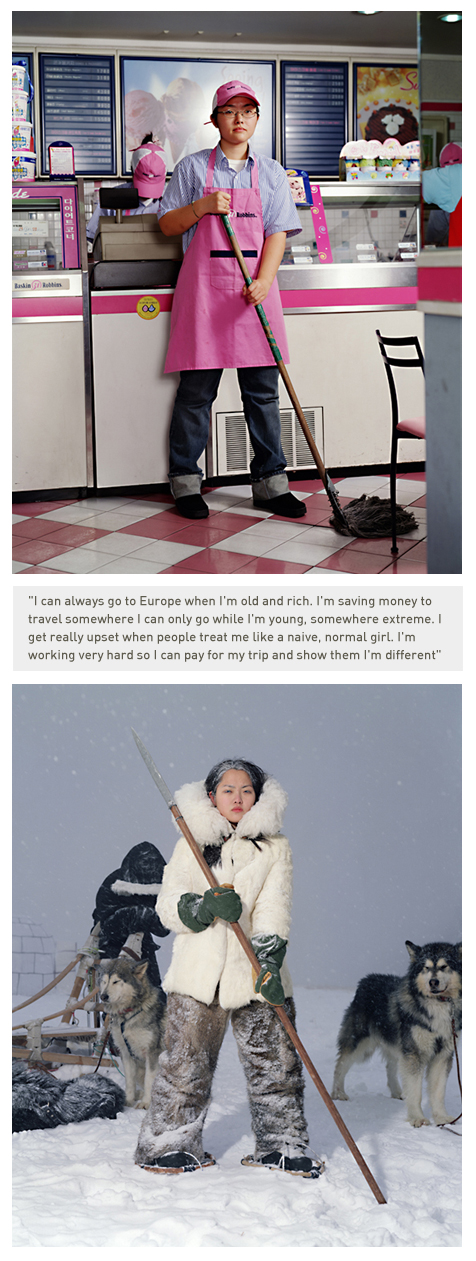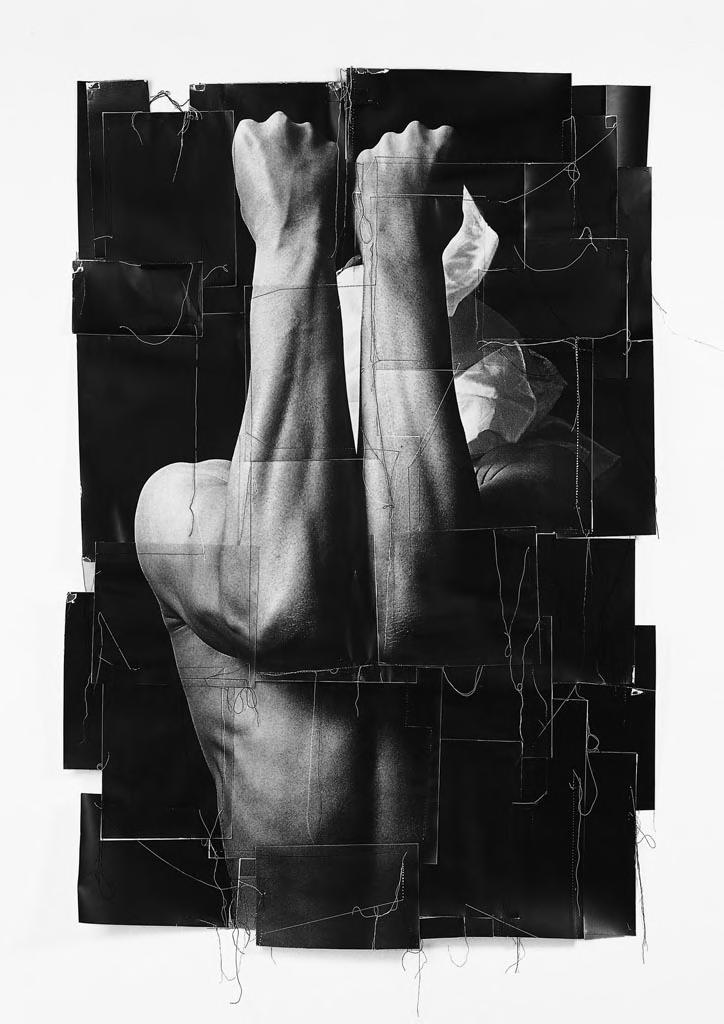Exhibition dates: 18th October 2009 – 3rd January 2010
Sekwon Ahn (Korean, b. 1968)
Triptych from the series Seoul New Town (Lights of Weolgok-dong, 2005; Disappearing Lights of Weolgok-dong I, 2006; and Disappearing Lights of Weolgok-dong II, 2007)
2005-2007
Chromogenic photographs
Courtesy of the artist © Ahn Sekwon
Great to have some really good quality photographs to show you from this exhibition!
Marcus
.
Many thankx to the Museum of Fine Arts in Boston for allowing me to publish the photographs in the posting. Please click on the photographs for a larger version of the image.
Sekwon Ahn (Korean, b. 1968)
Lights of Weolgok-dong
2005
Chromogenic photograph
Courtesy of the artist © Ahn Sekwon
Sekwon Ahn (Korean, b. 1968)
Disappearing Lights of Weolgok-dong I
2006
Chromogenic photograph
Courtesy of the artist © Ahn Sekwon
Sekwon Ahn (Korean, b. 1968)
Disappearing Lights of Weolgok-dong II
2007
Chromogenic photograph
Courtesy of the artist © Ahn Sekwon
Dae-Soo Kim (Korean, b. 1955)
Untitled
1999
From the series Bamboo (1998-2008)
Gelatin silver photograph, printed 2007
Santa Barbara Museum of Art; museum purchase with funds provided by PhotoFutures
Bien-U Bae (Korean, b. 1950)
Kyung ju
1985
From the series Sonamu
Gelatin silver photograph
The Museum of Fine Arts, Houston; museum purchase with funds provided by Photo Forum
This October, the Museum of Fine Arts, Houston, presents Chaotic Harmony: Contemporary Korean Photography, the most comprehensive exhibition of contemporary Korean photography to ever be shown in the United States. Organised by Anne Wilkes Tucker, The Gus and Lyndall Wortham Curator of Photography at the MFAH, and Karen Sinsheimer, Curator of Photography at the Santa Barbara Museum of Art, Chaotic Harmony features large scale photographs by 40 Korean artists, many of who have never before exhibited in international museum exhibitions and whose work will be on view in the United States for the first time in this show. At the MFAH, the works will be on display in the Audrey Jones Beck Building’s Cameron Foundation Gallery, as well as the Lower Beck Corridor, from October 18, 2009 through January 3, 2010, presenting a fascinating window onto the vital and constantly evolving country, Korea.
“As South Korea has exploded onto the international trade scene, South Korean artists have also emerged onto the global stage, which the recent high auction prices for Korean artwork attest to. Despite this fact, Korean art is still rarely presented in the United States, and the specific field of Korean photography is even less explored here,” said MFAH director Peter C. Marzio. “Following the MFAH’s tradition of presenting pioneering photography exhibitions, we are pleased to exhibit this brilliant survey of contemporary South Korean photography, which can be seen in the enhanced context of Your Bright Future and the museum’s Arts of Korea gallery.”
“Operating under a relatively new democracy in South Korea, artists experienced a burst of creative energy and freedom of expression in recent decades, and an entirely fresh perspective of modern-day Korea is presented in this show,” added curator Anne W. Tucker. “The photographers in ‘Chaotic Harmony’ observe the country’s notable growth in terms of industry and urbanisation and convey the resultant issues as well as reflect on the country’s ancient culture and religions.”
Within the exhibition, two distinct generations of Korean artists are represented: those born in the mid-1950s and 1960s, during a succession of military dictatorships when the country was still largely agrarian, and those born in the 1970s, predominantly in urban areas and who came into maturity in the new democratic era which began in 1987. With two exceptions, one work by each artist is included. Through recent works by both generations of photographers, Chaotic Harmony explores Korea through five thematic sections: land and sea; urbanisation and globalisation; family, friends, and memory; identity: cultural and personal; and anxiety.
Land and Sea
Most of the work represented in the “Land and Sea“ section of the exhibition was created by the first generation of Korean artists who traveled abroad for their graduate educations and brought their new ideas back to dramatically effect photographic styles in Korea. Nevertheless, many of them remained tied to Korean landscapes and traditions while embracing new aesthetic ideas. The extraordinarily beautiful land and seascapes in this section celebrate Korea’s surrounding oceans and the forests that cover large sections of its mountainous terrain. In addition, these photographers often explore religious practices that are primarily tied to nature. BAE Bien-u’s Kyung ju (1985, see photograph above) from the series Sonamu (which translates to “sacred pine grove“), documents mist-shrouded pine trees surrounding Gyeongiu, the ancient city of the Shilla kingdom (A.D. 668-935). KIM Young-sung’s Untitled photograph (2005) from the Dolman series, shows a man standing atop one of Korea’s 50,000 dolmans (or ancient tombs). Over 60 percent of the world’s 80,000 dolmans are located in Korea. Gap-Chul Lee has documented shamanism (as well as Buddhism) in Korea for decades, but most specifically in his series Conflict and Reaction (1990-2001).
Urbanisation and Globalisation
An ancient civilisation, South Korea has recently transformed into one of the world’s major global economies. Three-fourths of the population is categorised as urban, with half living in the country’s six major cities. Seoul is the world’s fourth largest metropolitan area. This section of the exhibition responds to the shift of the population from rural to city living, and the entrance of Korea on to the world stage. Young-Joon CHO’s Usual & Circle – Seoul Namdaemun, Rho Gwang-hyo (2005) is a diptych: the image on the left presents an urban area teeming with stores, advertisements, people, and traffic, while the image on the right isolates a woman who we would not have otherwise noticed in the larger view of the city. Her expression of emotional distress is consistent with all the isolated figures in the series. Ahn Sekwon documented Seoul’s rapid physical changes by photographing one particular neighbourhood of the Weolgok-dong section of Seoul in 2005, 2006, and 2007 as the old homes are destroyed to make room for new high rises. The resulting triptych (see photographs above) dramatically conveys the destruction of the modest-scale homes to make way for the towering scale of a modern city.
Family, Friends, and Memory
“Family, Friends, and Memory“ reflects the tensions in shifting societal values and practices as Korea continues its rapid growth. Traditionally, families followed Confucian norms: the father was the respected head of household and made decisions for his wife and children, financially supporting the family and arranging schooling and marriages. Social values have changed with increasing awareness of Western cultures through travel and the importation of Western products and media. Also with dramatic urban growth, came shifts from homes to crowded high rises, the entrance of women into the workforce, and other changes. Sunmin LEE’s photograph, Lee, Sunja’s House #1 – Ancestral Rites (2004, see below), portrays traditional values playing out in a modern setting: the men and boys of a family conduct traditional rituals in one room while the women watch from the doorway. Sanggil KIM’s Off-line: Burberry Internet Community (2005, see photograph below) depicts a modern phenomenon: people who met over the internet, united by a common passion, in this case, that of wearing Burberry Check (registered as a trademark of the Burberry brand) and enjoying an “off-line” get-together.
Identity: Cultural and Personal
Between 1910 to 1945, Japan annexed Korea and systematically attempted to eradicate Korean culture and identity, for example, by banning Korean literature and language from schools. Only six years after World War II, Korea was devastated by the Korean War. This section of Chaotic Harmony investigates what it means to be Korean today after this disruptive history. Some artists, such as Bohnchang KOO, seek to reclaim past cultural history, by photographing treasured and uniquely Korean items such as Celadon – the main type of ceramic produced in ancient Korea and generally exalted as Korea’s most significant artistic legacy. Jungjin Lee in term photographs native crafts from Korean folk culture. Exploring more personal aspects of identity is Yeondoo JUNG’s Bewitched #2 (below), a diptych juxtaposing images of the same teenager, mopping the floor of a Baskin Robbins in her day job and exploring the Arctic regions in her dream job (see photographs below); and Hyo Jin IN’s Violet #01 from the High School Lovers series (2007, below), which portrays an openly lesbian couple.
Anxiety
The “Anxiety” section of Chaotic Harmony investigates the constant tension provoked by strained relations and the potential of a violent outbreak between North and South Korea. Jung LEE’s Bordering North Korea, #2 (2005), from her 2005-2008 series of the same title, offers a view of North Korea seen from China and them superimposes over it an accompanying text chosen from the set phrases that North Koreans are allowed to say to the few foreigners who gain access to the country, such as Our country is the paradise of the people. She wants the viewer to experience both the beauty of the land and the palpable repression evident in the political slogans. Seung Woo Back references the subliminal fear of an attack from North Korea by staging “invasions” of toy soldiers that march across a family’s yard and up their wall to the kitchen window ledge, presumably unbeknownst to the person whose silhouette is visible though the window.”
Press release from the Museum of Fine Arts, Houston website [Online] Cited 11/11/2009 no longer available online
Yeondoo Jung (Korean, b. 1969)
Bewitched #2
2001
Sanggil Kim (Korean, b. 1974)
Off-line: Burberry internet community
2005
From the series off-line (2005)
Chromogenic photograph
Santa Barbara Museum of Art; museum purchase with funds provided by PhotoFutures
© Sanggil Kim
JeongMee Yoon (Korean, b. 1965)
Seo Woo and Her Pink Things
From The Pink and Blue Project (2005-2008)
© JeongMee Yoon
In “Family,” the last section of her essay, Sinsheimer addresses the traditional and changing structures of the Korean family: inter-racial marriage, Confucian traditions, the nuclear family, and the effects of consumerism on the younger generation. Sunmin Lee’s photograph of an ancestral ritual, Lee, Sunja’s House #1 – Ancestral Rites (2004, below), represents the loosening of Confucian practice as the participants wear Western dress. Yet modernisation goes only so far, since the women do not take part in this vestige of patriarchal society.
A pair of photographs from Jeong Mee Yoon’s The Pink & Blue Project (2005-2008, above), created during her studies in New York, shows portraits of children surrounded by their accumulated belongings arranged neatly on the floor. All pink for girls and all blue for boys, the massed items, suggest that a global consumerist culture, rather than national or ethnic values, determine male and female versions of identity and acquisition. As the author observes, these images of children engulfed by material abundance are “a portrait of consumerism.”
Hyewon Yi. “Review of Chaotic Harmony: Contemporary Korean Photography [exhibition catalog],” in Trans-Asia Photography Review Volume 1, Issue 1, Fall 2010 Creative Commons Attribution-NonCommercial-NoDerivatives 3.0 License
PA-YA (Korean, b. 1971)
Noblesse Children #12
2008
From the series Noblesse Children (2008)
Chromogenic photograph
Santa Barbara Museum of Art; museum purchase with funds provided by PhotoFutures
Sunmin Lee (Korean, b. 1968)
Lee, Sunja’s House #1 – Ancestral Rites
2004
From the series Woman’s House II (2003-2004)
Chromogenic photograph
© Sunmin Lee, courtesy of the artist
Sungsoo Koo (Korean, b. 1970)
Tour Bus
2005
From the series Magical Reality (2005-2006)
Chromogenic photograph
Courtesy of the artist © Sungsoo Koo
Chan-Hyo Bae (Korea, b. 1975)
Existing in Costume_1
2006
From the series Existing in Costume (2006)
© Chan-Hyo Bae
Chan-Hyo Bae has chosen the iconography of queenliness to express his own feelings of cultural estrangement. Originally from South Korea and currently living in London, England, Bae begins from very simple, common sentiments of foreignness. His works – large-format colour prints, in which he plays unidentified female British monarchs from the 13th to 19th centuries (all his works are untitled) – initially appear to be a cheeky sort of wish fulfilment. One is readily reminded of Yasumasa Morimura, the Japanese artist who casts himself in Western art’s biggest roles, and also, perhaps, of the phenomenon of cosplay – the subculture of dressing up like fictional or historical characters – which originates in Japan but has become popular throughout Asia and the rest of the world. Bae seems to be performing a blatant paradox: that of the outsider gleefully destabilising the hierarchies of a culture about which he has admittedly fantasised, but which has forbade him full entrance because of an unalterable ethnicity.
Text from the photography-now website [Online] Cited 09/05/2019 no longer available online
Hein-kuhn Oh (Korean, b. 1979)
So-young Kang, Age 16, 2003
2003
From the series Girl’s Act (2001-2005)
© Hein-kuhn Oh
Hyo Jin In (Korean, b. 1975)
Violet #02
2007
From the series High School Lovers (2007)
© Hyo Jin In, courtesy Sarah Lee Artworks & Projects
Bohnchang Koo (Korea, b. 1953)
In the Beginning, I
1991
Gelatin silver print with thread on paper
53 x 37 1/2 inches (135 x 95cm)
© Bohnchang Koo
Museum of Fine Arts, Boston
Avenue of the Arts
465 Huntington Avenue
Boston, Massachusetts
Opening hours:
Thursday – Monday 10am – 5pm
Closed Tuesday and Wednesday
















